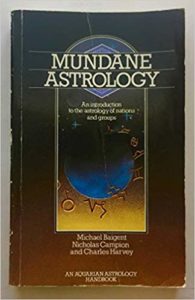The comprehensive astrological textbook Mundane Astrology: an Introduction to the Astrology of Nations and Groups (1984) benefits from the contributions of three accomplished astrological authors – Michael Biagent, Nicholas Campion and Charles Harvey – who raised the level of astrological discourse with their contributions. While readers need a familiarity with basic astrology to understand this book, those interested in the subject, whatever their level of knowledge, will find much valuable information. 
This is one of the excellent astrology books published by the U.K. based Aquarian Press in the 1980s. It begins with a concise history of western mundane astrology dating back to the Babylonians. Basic meanings of planets, houses and signs in mundane astrology are provided, along with information on various planetary cycles. Other topics include ingress charts, lunations, eclipses, Astrocartography, the astrology of cities and countries and much more. This book predates Biagent’s Astrology in Ancient Mesopotamia and Campion’s Book of World Horoscopes and The Great Year, and provides an introduction to those works. I had never read Charles Harvey before, and his discussion of planetary cycles is phenomenal, including many references to Andre Barbault’s work. He also addresses midpoints, giving us a better understanding of this topic, too. The work of Charles Carter and John Addey is also covered, and with numerous references to the works of others, the book serves as a resource for more.
A long section pulls the techniques together to analyze World War II, as many European astrologers failed to accurately forecast it (ironically, Americans Elizabeth Aldrich, Louise McWhirter and Evangeline Adams had all predicted U.S. involvement in a conflict years earlier).
While this is a long book, many chapters are inclusive in themselves. The Table of Contents and Index make it easy to find topics of interest.
And it’s time for a reprint! While the book is available second-hand, copies tend to be rather expensive. The charts are small and hand-written, and can be challenging to read. Planetary abbreviations at times also make for a less than fluent read (it took me a while to find the key and realize that SO stood for the Sun!). Notes and sources sometimes follow one chapter and other times are placed further along in the text. The use of a 90-degree dial around the outside of many of Harvey’s charts is not explained until the very end, and it would’ve been more helpful at the beginning. A tiny font detracts from the Index. (Perhaps the 1995 Thorson’s edition may have resolved some of these issues.)
But these are quibbles. Mundane Astrology is a classic of astrological writing, superbly researched and clearly written. The authors generously share their abundant knowledge, and anyone interested in this complex subject will profit from reading it.
Check out Mundane Astrology on Amazon.com
